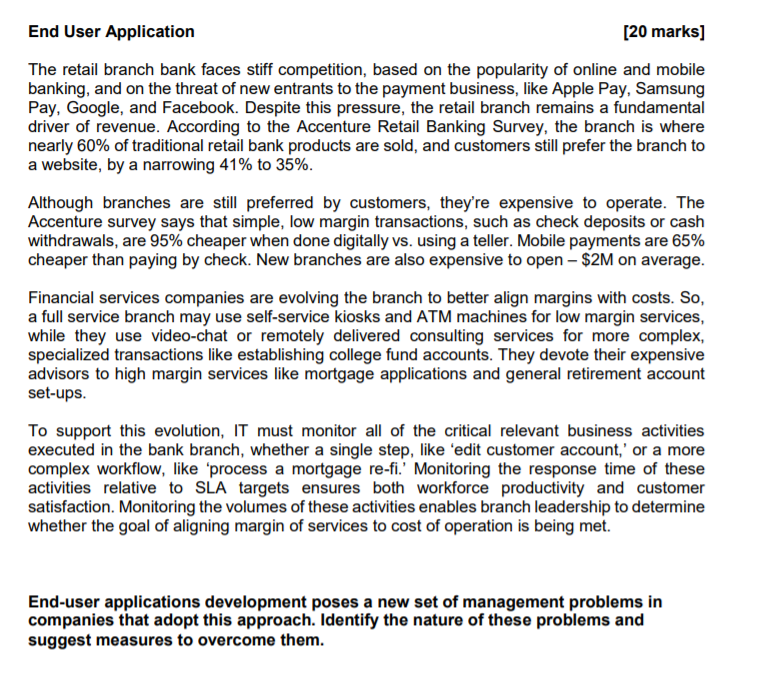
End User Application [20 marks] The retail branch bank faces stiff competition, based on the popularity of online and mobile banking, and on the threat of new entrants to the payment business, like Apple Pay, Samsung Pay, Google, and Facebook. Despite this pressure, the retail branch remains a fundamental driver of revenue. According to the Accenture Retail Banking Survey, the branch is where nearly 60% of traditional retail bank products are sold, and customers still prefer the branch to a website, by a narrowing 41% to 35%. Although branches are still preferred by customers, they're expensive to operate. The Accenture survey says that simple, low margin transactions, such as check deposits or cash withdrawals, are 95% cheaper when done digitally vs. using a teller. Mobile payments are 65% cheaper than paying by check. New branches are also expensive to open - $2M on average. Financial services companies are evolving the branch to better align margins with costs. So, a full service branch may use self-service kiosks and ATM machines for low margin services, while they use video-chat or remotely delivered consulting services for more complex, specialized transactions like establishing college fund accounts. They devote their expensive advisors to high margin services like mortgage applications and general retirement account set-ups. To support this evolution, IT must monitor all of the critical relevant business activities executed in the bank branch, whether a single step, like 'edit customer account,' or a more complex workflow, like 'process a mortgage re-fi.' Monitoring the response time of these activities relative to SLA targets ensures both workforce productivity and customer satisfaction. Monitoring the volumes of these activities enables branch leadership to determine whether the goal of aligning margin of services to cost of operation is being met. End-user applications development poses a new set of management problems in companies that adopt this approach. Identify the nature of these problems and suggest measures to overcome them. End User Application [20 marks] The retail branch bank faces stiff competition, based on the popularity of online and mobile banking, and on the threat of new entrants to the payment business, like Apple Pay, Samsung Pay, Google, and Facebook. Despite this pressure, the retail branch remains a fundamental driver of revenue. According to the Accenture Retail Banking Survey, the branch is where nearly 60% of traditional retail bank products are sold, and customers still prefer the branch to a website, by a narrowing 41% to 35%. Although branches are still preferred by customers, they're expensive to operate. The Accenture survey says that simple, low margin transactions, such as check deposits or cash withdrawals, are 95% cheaper when done digitally vs. using a teller. Mobile payments are 65% cheaper than paying by check. New branches are also expensive to open - $2M on average. Financial services companies are evolving the branch to better align margins with costs. So, a full service branch may use self-service kiosks and ATM machines for low margin services, while they use video-chat or remotely delivered consulting services for more complex, specialized transactions like establishing college fund accounts. They devote their expensive advisors to high margin services like mortgage applications and general retirement account set-ups. To support this evolution, IT must monitor all of the critical relevant business activities executed in the bank branch, whether a single step, like 'edit customer account,' or a more complex workflow, like 'process a mortgage re-fi.' Monitoring the response time of these activities relative to SLA targets ensures both workforce productivity and customer satisfaction. Monitoring the volumes of these activities enables branch leadership to determine whether the goal of aligning margin of services to cost of operation is being met. End-user applications development poses a new set of management problems in companies that adopt this approach. Identify the nature of these problems and suggest measures to overcome them







